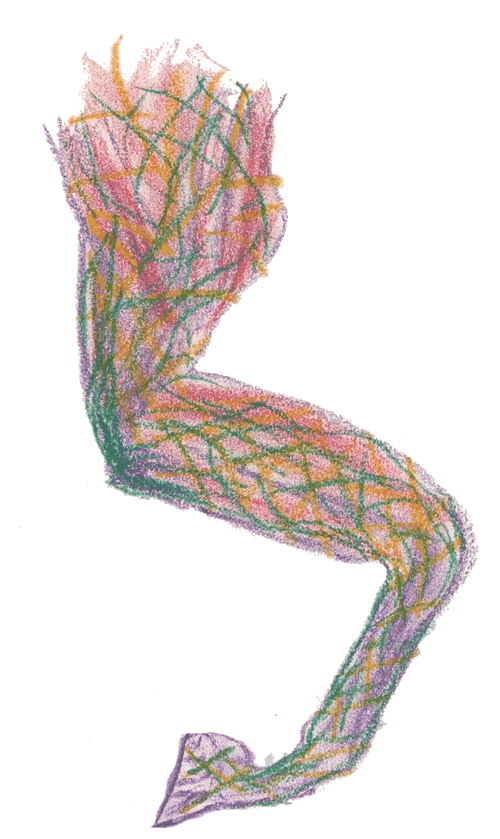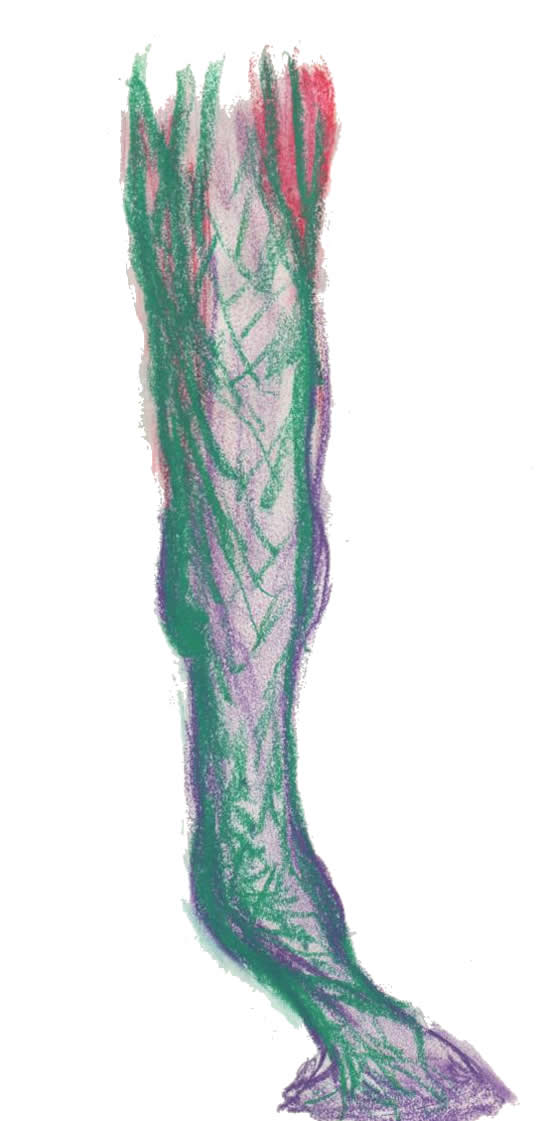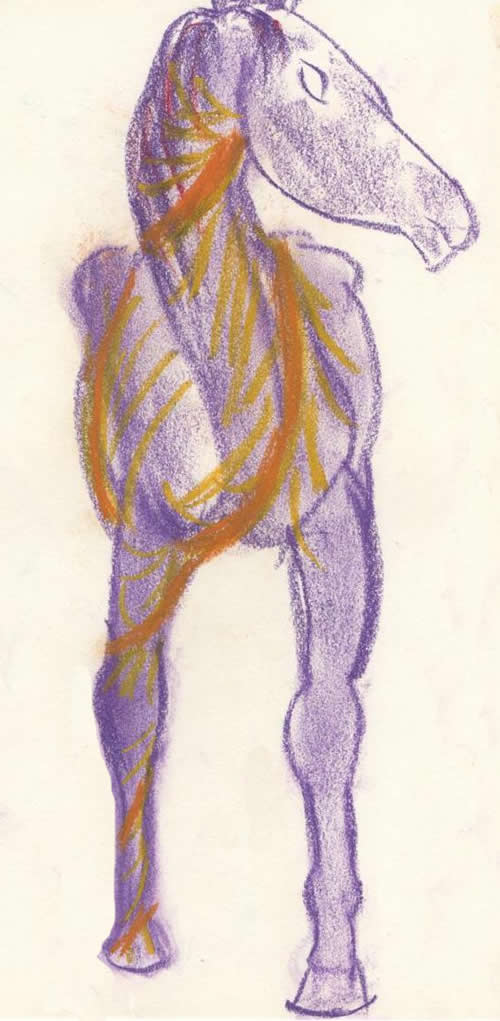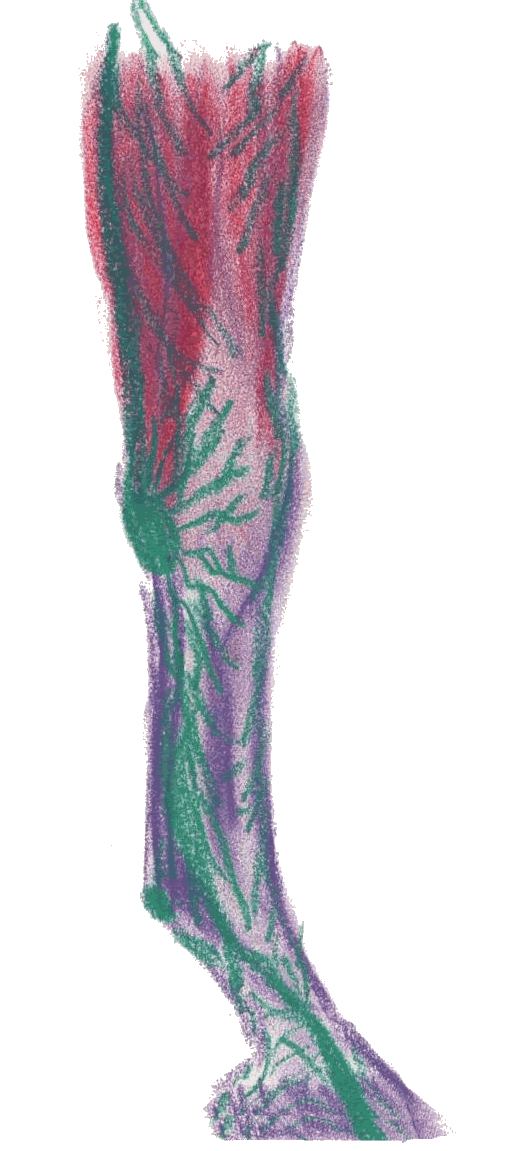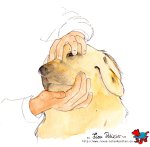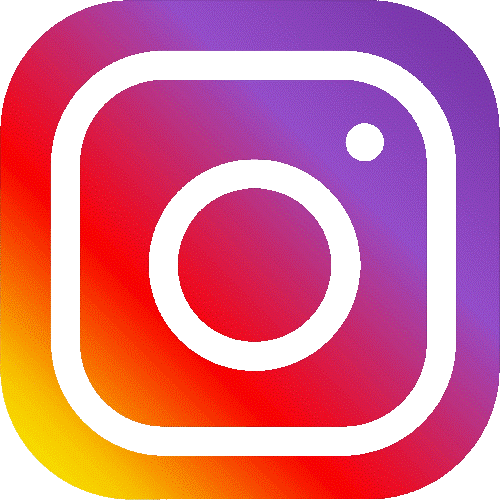Osteopaths, we now, on the whole, have heard about tensegrity and, most of us have admitted that this elastic understanding of body tissues being either in tension or compressed was really an easy way to explain how and why, while treating a fetlock, one could free an iliac bone on a horse ; or how you could get rid of a neck pain on a human being only by moving his fibula.
To summerize, tensegrity is dealing with body architecture which principles follow :
– In a structure, made of tensed ropes and compressed poles, in other words bones and muscles or fasciae...
– The excess forces are spread equally and allow the structure to absorb the energy in excess and to bend itself reversibly : fall on a knee and the excessive shock pressures and tensions spread very quickly all over the leg, hurting you right up to the lumbar area..., pinch your skin and you see wrinkles on several centimeters to spread the traction on more surface...etc...
– From one adaptation to the next one, the more dysfunctioned zone relaxes, taking off an acute problem from a joint and replacing it by a simple stiffness on the area.
– from one resilience to the other, this excess of energy can dissipate or not...
– with the ’J’ curve, which describes how a system under tensigrity responds to pression, we know this system will work until a certain point : my body is under pressure, then it makes itself more fluid before loosing its shape and coming back partially to its original tension. This is true on a certain intensity, but if the strength is too high, then fractures or strained muscles or ligaments occur...
Even if the vision of the fascias given by (Guimbertaud and its films->886) ...shows us clearly the fluidity of the system and how the tensions and forces are transmitted from one point to another, through physical restructuration of subcutaneous tissue , it is nevertheless difficult to link precisely a fibula to a neck, an iliac to a fetlock and the muscular chains described up to now are sometimes far-fetched, as the body does not always follow what is written in books, which should they, present a coherent and irrefutable reasoning...
That is why we have most of the time a rather blurry idea of the question even if the compression islands among an ocean of tensions described by the tensegritive physic mean a lot to us everyday on our patients.
Even if we understand that Pierre Tricot tissular osteopathy which uses pression as a parameter takes into account the first part of the ’J’ curve of tensigritive tissue to function.
Even if we see this body of flesh spinning and getting stuck somewhere else...
Even if...Do we use it the best we can? I do not think so, I think that we are on the edge of the significance of this notion in the interpretation of health and in the way of changing our osteopathy.
I do not pretend in this article to give you ’’the’’ tensegritive vision of the body, but I would like to give you a few tracks.
Then as usual, you can give your own thoughts about it.
Every cell, every fiber, every structure ...
Let’s stop looking at the body as a biochemical plant but as a framework which must be able to move all the time to follow the movements. Every part is conceved as a tension spreader and the forces going through the body find special strength lines to split themselves up in the most coherent way depending on each part resistance.
These lines are similar to the web worldwide circulations we can observe : both very loose with compulsery passage knots and more used canals, but which can also, in case of a lapse knot, spread differently.
Only putting a feet on the ground creates an impact force climbing along the leg and quite changing its tensions until the complete cushioning of the created force.
One could imagine a nearly homogenous web of tensions on the near frontleg of a lying horse in a field, completely relaxed.
As would show a green and yellow web of body tensions going through the different tissus ;
One can see a very homogenous web of forces spreading with the same intensity in every directions.
It only takes the horse to get up to see the forces spreading differently using this time privileged canals such as tendons, sesamoïds bones, joints etc...
One knows, when watching Dr Guimbertaud and his team’s films, that this new distribution is due to restructuration of the tissues which allow them to follow the forces directions. Fascial fibers are spread differently in order to support the induced force. The system changes shape as a whole.
So one see on this view a less probable homogenous distribution with on the whole thicker forces lines, and two privileged lines emphasizing antagonist extensors and flexors structures balancing themselves to hold the leg.
Physiologicaly, tissues change within their own structure and adapt depending on what they are asked for, to move or to hold a position.
But in pathology, what is happening ?
Helixes ?
Quite a while ago with Yves Guillard’s physiological torsion, I was assuming that a (fascial helix-1062) could get tight or change direction depending on the pathologies, and could show through a few quick tests the areas with important tensions ; and even, could help resolving easily with these same tests certain dysfunctions. Of course, when one seeks for this helix, one finds it. But does it exist?
If you listen to tensegrity and what it reveals us:
– rearrangement of tissues depending on the forces on them...
– then, it is obvious that an abnormality in the physiological torsion creates this fascial ribbon which would not exist otherwise this way, and while testing it, one creates it in a certain way. We only test if it can organise itself the way it should.
It then gives such a web organisation :
It shows in a normal organisation a light tension at the front. It can be tight or loose, or back to front all over or, only on some parts of its track. And the way it is, gives interesting informations, but of course does not give what is happening without the person testing, as the test adds force and intention...
Meridians ....
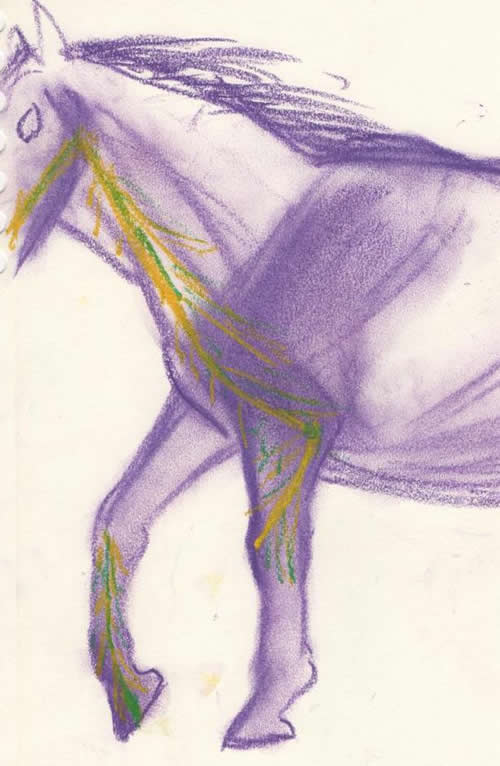
Chineese medicine and its meridans would also go through this reorganisation of the web. Here, a big intestine meridian on the front leg of a horse. Can it only be drawn or felt when it is in dysfunction? Or can it be tested by an acupuncturist who is looking for it?
In the same way, any trouble due to a big intestine dysfunction would change the fascial forces webs preferably in this area. Troubles which have been noticed for thousands of years by chineese doctors... and that Guimberteau in a way allowed us to see.
Then, in these conditions, isn’t it suprising that physical researches on meridians anatomy give mixed results, which fighters of the method quickly use to cry out for rip-off. One ought to review these researches taking into account the tension webs unstability in the body.
More regular, ...
This horse’s pisiform bone is in internal dysfunction (it can be easily moved towards the inside of the limb but not towards the outside), and one can notice that this bone and the fascias around it are under a strong forces and tensions attraction, that the fetlock area under it, is not concerned by most of the principal force currents which, on the contrary, pass now on the side, and thus, overload the perforated tendon bar (superficial flexor tendon) which, one would not be surprised of, will easily do work tendinitis, which will not intend to heal until normal force currents are re-established.
And nevertheless, how many horses are kept inside for too long because this simple rule is unknown? This, is everyday osteopathy : shortening of healing time or stopping chronicity or recurrences of this same problem by reharmonization of the area.
But, let us follow the force line up to its end and we then discover something less usual in our reasoning. It is Emmamnuel Pommier (aut 15) who made me notice something which, yet, was under our eyes. This force line materializes in the horses’s hoof. At this place, the hoof wall is thicker, denser, and can easily be felt. It is like finding a fine beam poutrelle IPN in the hoof as the one we put in a wall to strengthen it.
Its apparition is then the consequence of a bad distribution of the tensions in the limb and this beam forms itself as the hoof wall is being built ; so, if it can be felt right down to the ground, it means that the problem is at least a few monthes old. This is then apparently a simple consequence...
((But, what can be imagined is that this internal hoof tension is now maintaining in a feed back the trouble at the top of the limb)). And the consequence is that the re-harmonization of the limb and thus of the body can need correction of the excessive density in the hoof.
This correction can be made in some light cases with the finger, but most of the time, especially if the horse locomotion is irregular, it will be better to rasp the hoof vertically along the IPN beam in order to reduce it lightly and to allow keratin fibers to untight a little bit.
I sometimes asked a collegue to listen to the concerned limb, while I was rasping, to allow him to notice the immediate effect on most of the limb tensions.
One can also find the opposite effect, an area with low density, which then does not recieve enough tension forces from the web and deforms the hoof at the same place ; then one has to modify the area with the finger with the intention to densify the fibers ; in bad cases, one can approch a hot horse shoe which will have the same effect.
Clinical case.
Pepite is lightly lame, she lost her front right leg shoe the same morning. The osteopathic examination gives us these informations :
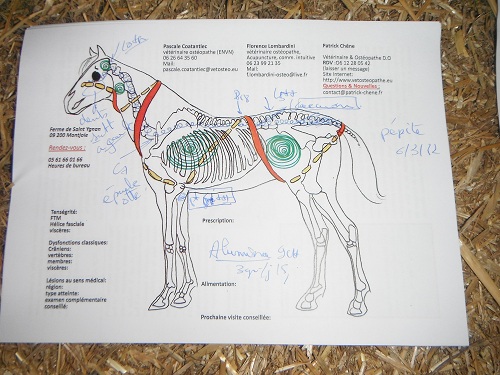
Clinical signs lead us to three main points :
– L5 in dysfunction, Yu point of the big intestine in chineese medicine.
– A dysfunction between the right radius and cubitus on the stimulation point of the big intestine
– A left temporo-mandicular joint dysfunction with irregular teeth on the left side of the mandibula. This brings a bad grinding of the food as well as bad fermentations of the caecum.
Three points which all lead us to a troubled big intestine meridian. Such a dysfunction is corrected by functional osteopathic technics.
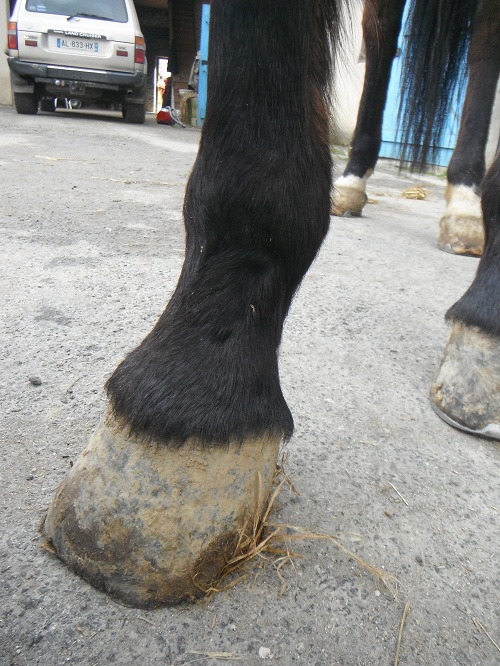
But one can also notice a vertical densification of the hoof wall, in line with the acupuncture point which starts the big intestine meridian on the coronet. This illustrates the tension web, which instead of being homogenely distributed, shows a particular line which becomes the main stream. And to be noticed : the start of the meridian can be seen (quite truly with difficulty on the photo...but very easily felt) on the hoof. One has to notice that it is on the right hoof, and this hoof lost its shoe which fell on its own.
The induration of the hoof is lightly rasped to allow the tensions web to untight more easily, in this case, the teeth should also be rasped to correct the dental table (and maybe add a probiotic to perfect the result of the manipulation).
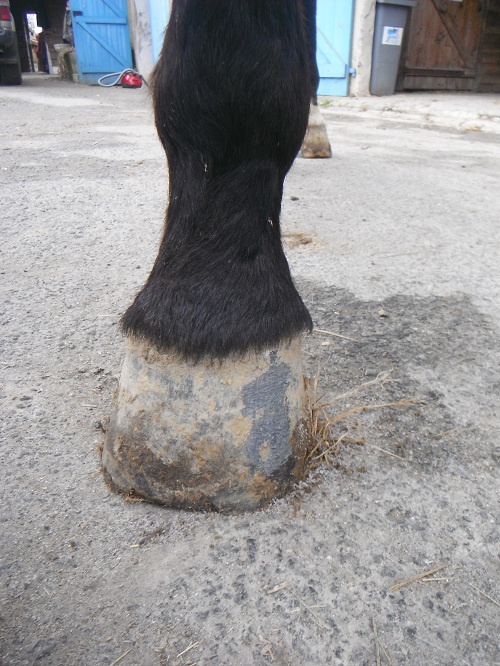
If one follows those tensegritive ways, then I believe that some difficulties in the explanation of numerous constatations disappear ... and I wonder which other ways are willing to open?
